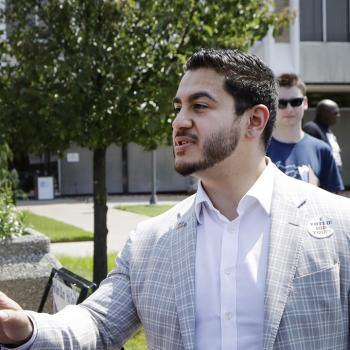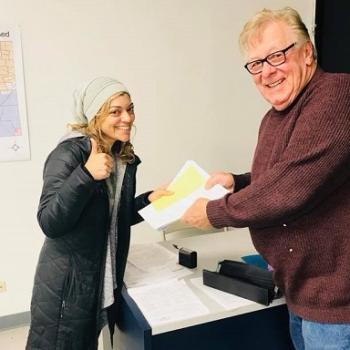 |
|
Hiding in plain sight
|
Every day people of Muslim backgrounds, those who merely look Muslim, and those who have a suspicious skin colour, face much hassle and sometimes harrassment at the hands of government authorities. In security checks at airports, in schools, in government buildings, and on the streets, racial and religious profiling happens extremely frequently in this country. Many of us have been profiled, including myself. Almost every time when I’m at the airport, a TSA officer pats down my hijab, though at least they have enough cultural sensitivity to have a woman do it. How can those who have been profiled, questioned, or detained, respond? Hasan Elahi is an artist who’s website Tracking Transcience is a subversive response to his being targeted by the FBI. Everyday, Elahi posts up photos of his daily activities, including photos of the meals he eats, where he shops, and where he goes. The site features a map which shows where Elahi is at all times, and is connected to a tracking device he carries around with him. By surveilling himself, Elahi shows that he can track himself much better than the FBI ever could.
![]() Can you briefly the describe the incident when you were detained at the airport?
Can you briefly the describe the incident when you were detained at the airport?
The short version is that I was returning from an exhibition in Dakar, Senegal where I was questioned by the FBI in Detroit. I was asked where I was, who I met with, why I was there, etc. I was also asked about a storage unit that I had and asked what the contents were. The FBI agent received an erroneous report that I had explosives in there. I think anyone that speaks to me for more than a few seconds realizes I’m no terrorist threat. He let me go and I ended up on my plane home (at that time) back to Tampa saying that the local office would get back in touch with me at a later date and we’d get this cleared up. (A longer version of this story can be found here.)
![]() How did that incident inspire you to make your self-surveillance website?
How did that incident inspire you to make your self-surveillance website?
It wasn’t specifically the incident at the airport (as that was only a couple of hours at most), but it was really what happened after the next six months. Having to justify every single moment of my life to the FBI during that entire time between the incident at the airport and the day I was subjected to nine consecutive polygraphs, it was really an attempt for me to understand what just happened. When the investigation was taking place, the last thing on my mind was “art project”. The web project was developed in a very organic process. It’s hard to say just when it started, but quite possibly right at the end of the investigation when they said everything was fine, and that’s when I asked if i could have a letter from the FBI saying exactly that. The problem is that in order to be formally cleared, I’d need to be formally charged. So it was a very awkward situation where all we needed was the last guy at the last airport not to get the last memo and here we go again – and we all knew that. But the FBI agent insisted that everything was OK and if I needed anything to call him. I told him that I was planning on traveling internationally in a couple of weeks and this was to be the first time since the investigation started and was a little nervous about being let back into the country. He asked me to call him with the flight details and he would take care of everything. So thus the birth of Tracking Transience with the first call to him reporting my whereabouts which has now continued in various forms for years. It’s not that I have to report my whereabouts or was required to at any point, but I decided to do that out of my own willing, a sort of a preemptive action to prevent further altercations. After a year or so of phone calls, this eventually developed into communicating openly with the FBI and that’s when I developed the web project. This way not only could the FBI monitor me, but so can everyone else.
![]() How does your website fit into your larger body of work?
How does your website fit into your larger body of work?
I’m going to cheat a little bit here and paste the text from a recent exhibition I had at SITE Santa Fe – the curator that wrote this really hit it on the head perfectly! “Elahi’s interest in surveillance, borders, and the geopolitical conditions that produce and maintain them is not confined to his own experience. Works produced in parallel to his Tracking Transience project investigate similar issues. The work Flow Wet Feet (Dry Feet) (1999-2006), consisted of a multi-channel video on several monitors placed on the floor. The monitors screened footage of an empty Sunrise Beach, Florida, the site of a 1999 incident in which the US Coast Guard intercepted Cuban immigrants attempting to enter the country. Other works poetically evoke historical traumas. Gorée Island Remix (2003) was filmed at the Door of No Return in the House of Slaves on Gorée Island in Senegal. The five minute film shows the feet of several different people stepping into and out of the frame, with the vast expanse of the Atlantic Ocean visible in the distance. Gorée Island Remix hints at the history of the transatlantic slave trade for which the Door of No Return has become a symbol. S21 (2005) is a video that was shot in the Tuol Sleng and Cheong Ekk Genocide Museums in Phnom Penh, Cambodia, both of which served as prisons during the Khmer Rouge era. S21 was shown as part of an exhibition staged in the building that served as the headquarters for the former East German secret police, reinforcing the international existence of repressive regimes.”
![]() Is it unnerving to put your whole life on display? Are you able to draw a line between the personal and the public, or does that not matter?
Is it unnerving to put your whole life on display? Are you able to draw a line between the personal and the public, or does that not matter?
Certainly not. As much of my life is out there publicly, I live an incredibly anonymous and private life. There’s so much information about me out there that it all becomes noise at a certain point, and the noise is growing daily. Putting my life on display has become as commonplace as checking my email, voicemail, or my Facebook page. It is something that I have internalized to the point where I don’t even know I’m doing it. But I’m not the only one doing this. When I first started this project back in late 2003, people thought I was out of my mind when I said I wanted to create this device that would let everyone know where I was at all times and what I was doing. Well, not even 7 years later, we have about 400 million people on facebook doing roughly the same thing each time they update their status. To put that in perspective, if Facebook was a country, it would be the world’s third most populous country after China and India.
![]() What sort of commentary are you making on homeland security with your website?
What sort of commentary are you making on homeland security with your website?
It’s basically a way of showing that I can watch myself a lot better than they ever could, and I could get a level of detail that they would never have access to. Also, by providing the information directly to the public, bypassing the intelligence agencies, it devalues their currency. They all operate in an industry where their currency is information and that information has value because no one else has access to it. On an individual basis, it’s a symbolic gesture. If 300 million people started doing this, the FBI would potentially need to hire another 300 million people to keep up with the information, possibly even more, and quite plausibly the system would collapse. East Germany tried this a few decades back; it didn’t work out to be such a great plan for them in the end.
![]() What do you think about the age we live in today, of mass amounts of information being made available and accessible about other people’s lives?
What do you think about the age we live in today, of mass amounts of information being made available and accessible about other people’s lives?
We’re caught in different rates of speed. The technology is moving at one speed. The culture is moving at another…we’re quickly adapting, but still considerably slower than at the rate the technology is moving. And then there’s policy and government, which are moving at a glacial pace. We’re developing and using technology at a rate where we hardly have the time to assess the social implications of that is happening, much less coming up with way to come up with a legal policy to apply it.
Hena Ashraf is a filmmaker and an advocate for the making and use of independent media. She can be reached at hena@a2palestinefilmfest.org.












